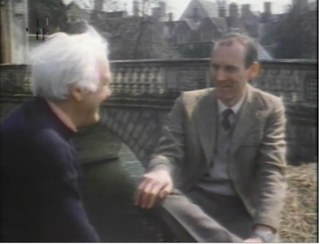
The Royal Astronomical Society (RAS) is a learned society and charity that encourages and promotes the study of astronomy, solar-system science, geophysics and closely related branches of science. Its headquarters are in Burlington House, on Piccadilly in London. The society has over 4,000 members, known as fellows, most of whom are professional researchers or postgraduate students. Around a quarter of Fellows live outside the UK.

The Gold Medal of the Royal Astronomical Society is the highest award given by the Royal Astronomical Society (RAS). The RAS Council have "complete freedom as to the grounds on which it is awarded" and it can be awarded for any reason. Past awards have been given for "outstanding personal researches in the fields of astronomy and geophysics" as well as general contributions to astronomy and geophysics "that may be made through leadership in research programmes, through education and through scientific administration". It has been awarded both for research that has taken a lifetime, and for specific pieces of research.
The Eddington Medal is awarded by the Royal Astronomical Society for investigations of outstanding merit in theoretical astrophysics. It is named after Sir Arthur Eddington. First awarded in 1953, the frequency of the prize has varied over the years, at times being every one, two or three years. Since 2013 it has been awarded annually.
The Jackson-Gwilt Medal is an award that has been issued by the Royal Astronomical Society (RAS) since 1897. The original criteria were for the invention, improvement, or development of astronomical instrumentation or techniques; for achievement in observational astronomy; or for achievement in research into the history of astronomy. In 2017, the history of astronomy category was removed for subsequent awards and was transferred to a new award, the Agnes Mary Clerke Medal.

Frederick John Vine FRS is an English marine geologist and geophysicist. He made key contributions to the theory of plate tectonics, helping to show that the seafloor spreads from mid-ocean ridges with a symmetrical pattern of magnetic reversals in the basalt rocks on either side.
Keith Edward Bullen FAA FRS was a New Zealand-born mathematician and geophysicist. He is noted for his seismological interpretation of the deep structure of the Earth's mantle and core. He was Professor of Applied Mathematics at the University of Sydney in Australia from 1945 until 1971.

The Chapman Medal is an award of the Royal Astronomical Society, given for "investigations of outstanding merit in the science of the Sun, space and planetary environments or solar-terrestrial physics". It is named after Sydney Chapman (1888–1970), a British geophysicist who worked on solar-terrestrial physics and aeronomy. The medal was first awarded in 1973, initially on a triennial basis. From 2004-2012 it was awarded biennially, and since 2012 has been annual.
Price Medal is a medal of the Royal Astronomical Society, for investigations of outstanding merit in solid-earth geophysics, oceanography, or planetary sciences. The medal is named after Albert Thomas Price. It was first awarded in 1994 and was initially given every three years. In 2005 this switched to every two years, and from 2014 it has been awarded every year.
Andrew Christopher Fabian is a British astronomer and astrophysicist. He was Director of the Institute of Astronomy, University of Cambridge from 2013 to 2018. He was a Royal Society Research Professor at the Institute of Astronomy, Cambridge from 1982 to 2013, and Vice-Master of Darwin College, Cambridge from 1997 to 2012. He served as president of the Royal Astronomical Society from May 2008 through to 2010.
(Stanley) Keith Runcorn was a British physicist whose paleomagnetic reconstruction of the relative motions of Europe and America revived the theory of continental drift and was a major contribution to plate tectonics.

Geophysical Journal International (GJI) is a monthly peer-reviewed scientific journal in the field of geophysics. It is published by Oxford University Press on behalf of two learned societies: the Royal Astronomical Society (RAS) and the Deutsche Geophysikalische Gesellschaft, who select and peer-review the contents.
Christopher Hugh Chapman is a British seismologist, an emeritus honorary professor in the Department of Earth Sciences, University of Cambridge.

Kathryn Anne "Kathy" Whaler OBE FRSE FAGU is a professor of geophysics at the University of Edinburgh School of GeoSciences, in the Research Institute of Earth and Planetary Science and is a member of the Solid Earth Geophysics and Natural Hazards Research Group.
Haley Gomez MBE, FRAS, FLSW is a Welsh Professor of Astrophysics at Cardiff University. She studies the formation and evolution of cosmic dust using the Herschel Space Observatory. She is Deputy Head of the School of Physics and Astronomy. She was awarded an Order of the British Empire in the 2018 Queen’s Birthday Honour’s.

Sara Samantha Russell is a professor of planetary sciences and leader of the Planetary Materials Group at the Natural History Museum, London. She is a Fellow of the Meteoritical Society and of the Royal Astronomical Society.

Emma J. Bunce is a British space physicist and Professor of Planetary Plasma Physics at the University of Leicester. She holds a Royal Society Wolfson Research Merit Award. Her research is on the magnetospheres of Saturn and Jupiter. She is principal investigator (PI) of the MIXS instrument on BepiColombo, was deputy lead on the Jupiter Icy Moons Explorer proposal, and co-investigator on the Cassini–Huygens mission.
Cathryn N. Mitchell is a Professor of Electronic & Electronic Engineering at the University of Bath. She was awarded the 2019 Institute of Physics Edward Appleton Medal and Prize.







